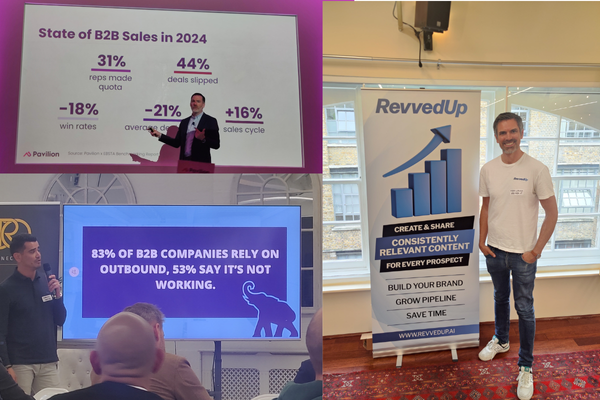10 Essential Insights from EMEAs Top GTM Leaders

The old 'predictable revenue' playbook is dead and buried - and so will any company who refuses to adapt and innovate. But what's next? I share the focus areas and approaches being used by the best companies in my top 10 take-aways from EMEAs top GTM operators.
I’ve had the privilege of attending 3 days of incredibly insightful talks, starting with the CRO Connected event, followed by 2 days at Pavilion’s GTM EMEA summit.
From Operating Partners at PE firms to founders & CEOs, CMOs & CROs, operators and investors, late stage enterprises to early traction scaleups…there’s been a lot to take in.
One thing I’m grateful for is how little I heard the same old, tired advice on ‘how to grow’ of ‘focus’, ‘know your ICP’ and ‘hire the right people’.
All of these just have to be a given (I know they’re often not in practice, and the actual application of these principles is frequently lacking)...but as a ‘secret to success’ they’ve been flogged to death in talks and panels.
So what was discussed?
Here I’ll share my top 10 take-aways:
1. Content is King (again). To win, you have to educate your market! if you're not investing in content and building a media machine, it's likely you'll lose out to your competitors (or let inertia beat you).
Trying to compete only for the <3% of buyers in-market at any given time (demand capture) has gotten way too expensive and competitive…the smart play is to be first choice before they’re ready to buy (demand creation), so you’re the preferred choice already when they hit that stage of their buyer journey.
2. Brand moves the needle. Relatedly, you pay for a lack of investment in brand with buyer indifference. Being too focussed on short-term goals will kill you eventually. If you’re going to win out in competitive markets and encourage buyers past the indecision that kills too many deals, you have to give them confidence that you’re best-in-class.
That often involves building a strong position in their minds well before they every speak to your sales reps.
3. Clarity of Communication. To do either of the above things well, you have to develop a Point of View, and communicate it clearly and consistently - what do you want to be famous for? And with who? Precision, focus and dictatorial application are essential to making this work.
You don't have to invest in a full rebrand or website overall to enjoy many of these benefits...but you should engage in a proper bottoms-up positioning exercise (starting with your customers).
4. Applied AI. It was great to hear talks sharing examples where AI is genuinely driving efficient and effective outcomes for those GTM teams who are embracing it, helping them achieve incredible things at speed and with smaller headcounts.
That said, it was still a very small sample size of leaders able to share real, operational examples of AI driving business change. For us AI native vendors, we must do better at supporting businesses in making the transition to this new way of working.
5. ELG is the third pillar. There was lots of excitement around ecosystem-led growth and partnerships as a key pillar to successful GTM motions. It feels like after growing quickly in the last couple of years, it's fully establishing itself as a core ‘third pillar’ of GTM alongside ‘Inbound’ & ‘Outbound’.
6. Innovation and creativity. They say necessity is the mother of invention. And I believe it to be true for GTM teams.
There are finally some exciting, creating and fresh ideas that are emerging from the pipeline crisis. From media machines to founder branding, scalable ABM to B2B influencers, community demos to the metaverse (that's a joke…there’s still nobody talking about the metaverse!)
The next 12-18 months will be super exciting for those who embrace the need to change (and it'll be miserable for those who insist on executing the same old playbooks).
7. Reality v Spreadsheets. The evidence is impossible to ignore - I saw so many different independent data sources showing that the median rate of growth has been cut to 20-25% YoY for most SaaS businesses.
Which correlates almost exactly to the fact only 25% of sales people hit quota. Why? Because every VC-backed business plan promises 100% YoY growth (at least!).
This means these plans are pure fiction in the majority of cases, and reps and their GTM leaders face the consequences of not delivering.
But it doesn’t have to be that way…if they’re willing to break out and try new things.
8. No victims. One of the speakers, who’s been through one hell of a ride during their tenure at a high growth, high profile (and highly tumultuous) scaleup was asked how they didn’t burn out.
I loved their answer…its because they actively chose to be there. They were never a victim of circumstances. They never griped about what the company was going to them. They owned their situation. As did their executive peers (who stayed).
I see so many people moan about what their companies get wrong…if you’re going to succeed through the dark valleys of building a startup, surround yourself with a team who never feel like victims.
9. Marketing’s time to shine. Given all of the above - the renewed focus on content and communication as growth levers, it’s no surprise that I believe marketing is going to be a lot more powerful over the next 5 years in the GTM mix.
I think more and more marketing teams will carry direct revenue responsibility and be measured on results…but they’ll be delivered through programmes that target their ICP, scale ABM and educate their market whilst building distinctive brands.
10. Value-Led Growth. All of this points to the emergence of a new era - Value Led Growth. Finding a way to consistently deliver value to prospects, educate them and spark a conversation will become a critical, core competency for every GTM team.
You can no longer afford to just burn through vast numbers of leads in your TAM, deploying an AI agent to spam 10s of thousands of emails a month to drive untargeted meetings. Is it highly efficient? Sure! It’s also wildly ineffective and short-termist.
If you’re keen to do things differently, share highly relevant, educational content with your prospects so that you can communicate value to everyone, including the 97% who aren’t ready to buy (yet), then we should talk.




